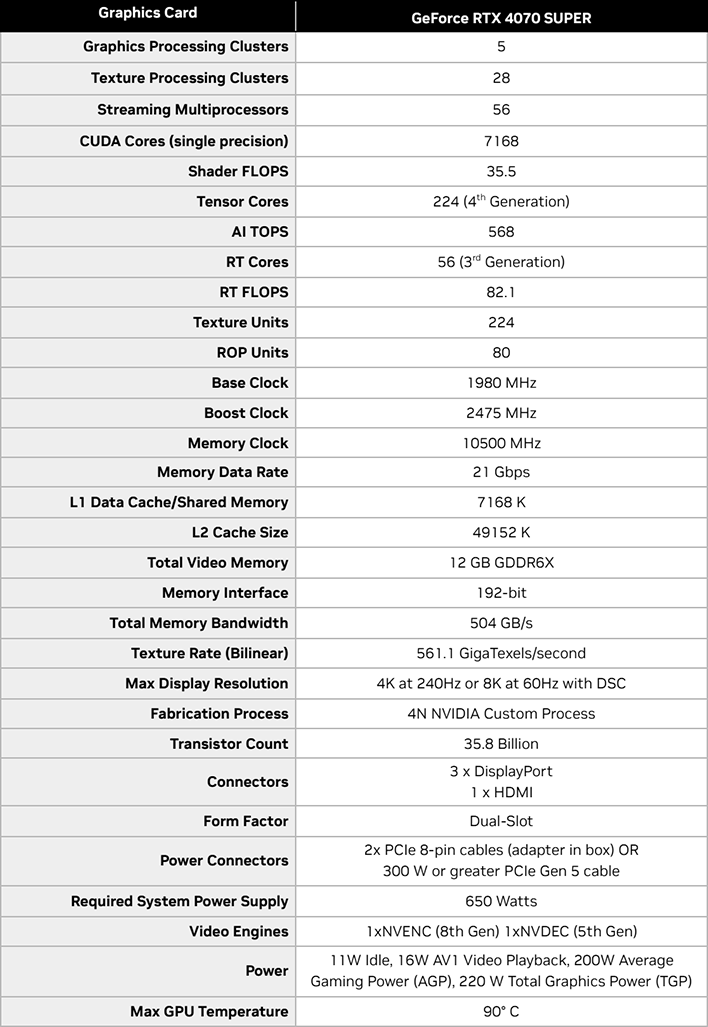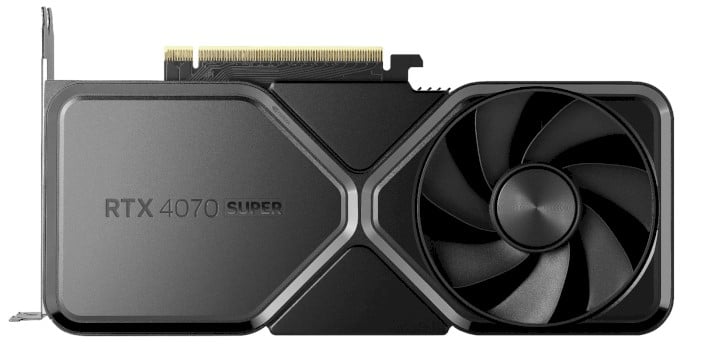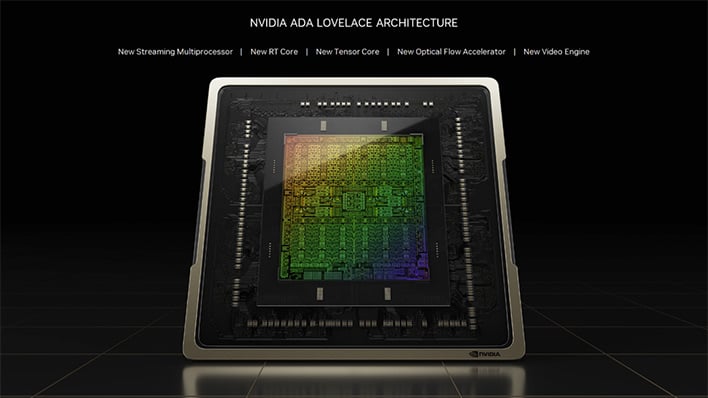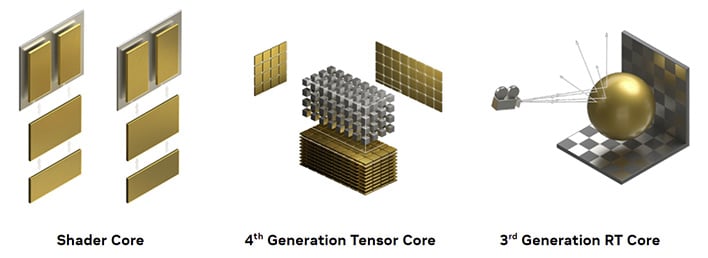GeForce RTX 4070 Super Review: NVIDIA Delivers More Performance And Value
NVIDIA GeForce RTX 4070 Super: Boosting Perfomance At A Lower Introductory MSRP
| NVIDIA GeForce RTX 4070 Super: MSRP $599 The new NVIDIA GeForce RTX 4070 Super offers nearly the same performance as the GeForce RTX 4070 Ti, for hundreds of dollars less.
|
|||

|

|
||
CES 2024 was an eventful show for NVIDIA. Not only did the company unveil a number of software and AI-related technologies, but it refreshed its GeForce RTX 40-series with a trio of new “Super” GPUs, targeting a broad swathe of the market. Although they had been rumored for months, the GeForce RTX 4070 Super, RTX 4070 Ti Super, and RTX 4080 Super were all officially unveiled at CES this year.
Their branding makes it obvious where each card falls in NVIDIA’s GeForce RTX 40 series product stack. But over and above their introductions, NVIDIA is re-jiggering prices and dispatching a few of the originally released RTX 40 series cards. Over the next couple of weeks, we’ll get to show you how they all perform, but today we’ll be focused on the most affordable Super in the bunch, the GeForce RTX 4070 Super. As its name suggests, the GeForce RTX 4070 Super falls somewhere in between the original GeForce RTX 4070 and the more powerful RTX 4070 Ti. Before we show you exactly where it lands, however, let’s check out some specs and take a look at the card itself...
NVIDIA GeForce RTX 4070 Super Specifications

All of the previously-launched cards in the GeForce RTX 40 series leverage the same Ada Lovelace GPU architecture but were built using a variety of chips. The flagship RTX 4090 is built around the largest AD102 GPU, the GeForce RTX 4080 uses the smaller (but still large) AD103, the GeForce RTX 4070 and 4070 Ti uses the smaller still AD104. The new GeForce RTX 4070 Super we’ll be showing you here is also powered by the AD104, but its core counts and clocks have been tweaked to hit a different performance target.
In terms of feature support, the AD104 is identical to the larger AD102 and AD103. All of the GPUs offer the entirety of features inherent to the Ada Lovelace architecture, like DLSS 2/3/3.5 and other NVIDIA technologies like NVIDIA Reflex latency reduction, NVIDIA Broadcast, Ansel, G-SYNC, Omniverse, optional Studio drivers, and GeForce Experience, to name just a few. This is an important point to consider in our opinion, because today’s high-end GPUs are used for much more than gaming and software features and support can be significant differentiators.
For a more detailed explanation of the Ada Lovelace GPU architecture, we suggest reading this article and checking out our launch coverage of the GeForce RTX 4090 while you’re reading. There's a ton of information in that article that we won’t be re-hashing again here.
As is the case with all of NVIDIA’s more mainstream GPUs, the AD104 as configured on the GeForce RTX 4070 Super is scaled down from the full implementation of the chip in a few ways.
The AD102 on the RTX 4090 has 11 GPCs, 64 TPCs, 16,384 CUDA cores, 512 Tensor cores, and 128 RT cores, with a 384-bit memory interface. The smaller AD103 has 7 GPCs, 38 TPCs, 9,728 CUDA cores, 304 Tensor cores, and 76 RT cores, with a 256-bit memory interface. In its full configuration, the AD104 has 5 GPCs, 30 TPCs, 7,680 CUDA cores, 240 Tensor cores, and 60 RT cores, with a 192-bit memory interface. The AD104 is effectively scaled down in every way that affects compute and rasterization performance, and memory bandwidth, versus its higher-end counterparts. As a result, the AD104’s transistor count is also much lower at 35.8B, versus 45.6B for the AD103, or 76.3B on the big-daddy AD102. We should also note, that both the AD102 on the GeForce RTX 4090 and the AD103 on the GeForce RTX 4080 are not full implementations of the chips; they’re both pared down somewhat as well in comparison to the full GPU designs.
Of course, the AD104 on the GeForce RTX 4070 Super is also scaled down from the full configuration of the chip in a few ways. Half of the AD104's NVENC / NVDEC blocks are disabled and the RTX 4070 Super features 7,168 CUDA cores, 224 Tensor cores, and 56 RT cores. The typical boost clock should hover in the 2,475MHz range and the 12GB of GDDR6X memory on the card operates at an effective data rate of 21Gbps, which equates to about 504GB/s of memory bandwidth over the RTX 4070 Super's 192-bit memory interface. If you’re familiar with NVIDIA’s current line-up, you’ll notice that the GeForce RTX 4070 Super has a similar memory configuration to the RTX 4070 and RTX 4070 Ti, but more Texture Processing Clusters, more Streaming Multiprocessors, and hence more CUDA, Tensor, and RT cores than the 4070, which also results in significantly more L2 cache, in addition to increased compute and texturing performance. For reference, the GeForce RTX 4070 is packing only 5,888 CUDA cores, 184 Tensor cores, and 46 RT cores.
Meet The GeForce RTX 4070 Super Founders Edition
The cooling setup on the GeForce RTX 4070 Super Founders Edition looks similar to previous cards with the dual-fan, pass-through design, but is shrunk down for a smaller form factor and now features an all-black design, which we think looks great. The GeForce RTX 4070 Super is only about 9” long, 4” high (it’s no higher than the slot bracket), and it requires only two slots.
The GeForce RTX 4070 Super features dual axial fans and a split heatsink design. One end of the heatsink array sits directly atop a heat plate that is affixed to the GPU and memory, with one fan on top. That fan directs air through the heatsink and immediately channels it out of the chassis through vents in the case bracket. The portion of the heatsink on the back half of the card, however, which is linked to the front via heat-pipes, allows air from the second fan to pass all the way through the card, where it is meant to rise to the top of the chassis and be expelled from the system, assuming the chassis has adequate ventilation.
The pass-through style cooler works in conjunction with a dense, short PCB design. Like earlier GeForce RTX cards, the new 4070 Super Founders Edition also features a 12+6 pin 12VHPWR power connector, though some partner boards will continue to use the traditional PCIe connectors that have been around for ages. NVIDIA includes an adapter with the GeForce RTX 4070 Super that converts dual 8-pin PCIe connectors to the newer 12VHPWR ATX 3.0 design.
Like most of the other members of the GeForce RTX family, the GeForce RTX 4070 Super has triple full-sized DisplayPorts and a single HDMI output on its case bracket. That HDMI port is HDMI 2.1-compliant, which enables 4K120P with G-Sync on some of the latest HDTVs and allows for 8K resolution over a single cable. The DisplayPorts are only DP1.4, however, which is a distinct disadvantage versus AMD’s Radeon RX 7000 series, which feature support for DP 2.1. Support for DP 2.1 means the latest Radeon cards are capable of supporting 4K resolutions at up to 480Hz and 8K resolutions up to 165Hz. While the maximum DP data rate on the Radeons tops out at 54Gbps, which doesn’t meet the standard’s maximum 77.3Gbps, it’s still plenty fast to support next-gen displays arriving over the course of this year.














